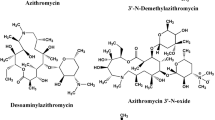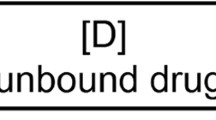Abstract
In drug discovery and development, it is very important to investigate the plasma protein binding (PPB) of a drug to better understand its in vivo fate. In this study, a rapid and low-cost solid-phase extraction (SPE) method was developed for determining the PPB. With this method, the total protein recovery of a blank human plasma sample was 83.7 %. The unbound drug was easily adsorbed by an ODS C18 SPE column, and the recovery of three known drugs was more than 90 %. Their PPBs obtained by the SPE were identical to the value reported by conventional techniques. In addition, more than 90 % of 4-amino-2-trifluoromethyl-phenyl retinate (ATPR), which is a novel all-trans retinoic acid derivative (ATRA), was bound to human plasma protein as determined by SPE, and this value was comparable with that obtained by our previously described gel filtration-based method. Considering its versatility, speed of separation, and low cost, SPE is a rapid and economical method for measuring PPB.






Similar content being viewed by others
References
Vuignier K, Schappler J, Veuthey JL, Carrupt PA, Martel S (2010) Drug-protein binding: a critical review of analytical tools. Anal Bioanal Chem 398:53–66
Shaw LH, Tsai TH (2012) Simultaneous determination and pharmacokinetics of protein unbound aspirin and salicylic acid in rat blood and brain by microdialysis: an application to herbal-drug interaction. J Chromatogr B 895–896:31–38
Vuckovic D, Zhang X, Cudjoe E, Pawliszyn J (2010) Solid-phase microextraction in bioanalysis: new devices and directions. J Chromatogr A 1217:4041–4060
Oravcova J, Bohs B, Lindner W (1996) Drug-protein binding sites new trends in analytical and experimental methodology. J Chromatogr B Biomed Appl 677:1–28
Howard ML, Hill JJ, Galluppi GR, Mclean MA (2010) Plasma protein binding in drug discovery and development. Comb Chem HighThroughput Screen 13:1–18
Berrueta LA, Gallo B, Vicente F (1995) A review of solid phase extraction: basic principles and new developments. Chromatographia 40:474–483
Huck CW, Bonn GK (2000) Recent developments in polymer-based sorbents for solid-phase extraction. J Chromatogr A 885:51–72
Żwir-Ferenc A, Biziuk M (2006) Solid Phase extraction technique-trends, opportunities and applications. Pol J Environ Stud 15:677–690
Shen J, Shi JB, Chen FH, Wang Y, Ruan JJ, Huang Y (2009) Synthesis and antitumor activity of all-trans retinoic acid derivatives. Chin Chem Lett 20:809–811
Bartley IM, Hodgson B, Walker JS, Holme G (1972) The use of acid alumina and sephadex LH-20 for the separation and characterization of ethanol-soluble peptides produced by bacillus brevis. Biochem J 127:489–502
Smith JE, Milch PO, Muto Y, Goodman DS (1973) The plasma transport and metabolism of retinoic acid in the rat. Biochem J 132:821–827
Pochon F, Amand B, Lavalette D (1978) Rotational relaxation of free and protease-bound alpha2-macroglobulin. J Biol Chem 253:7496–7499
Tang JH, Yao J, Waddad AY, Zhou JP, Chen FH (2013) Interaction of a novel all-trans retinoic acid derivative with bovine serum albumin and human plasma protein studied by gel filtration (sephadex LH-20) and fluorescence quenching method. Lat Am J Pharm 32:392–399
Vuignier K, Veuthey JL, Carrupt PA, Schappler J (2013) Global analytical strategy to measure drug-plasma protein interactions: from high-throughput to in-depth analysis. Drug Discovery Today. 18(21–22):1030–1034
Drugbank: http://www.drugbank.ca/drugs/DB00393
Li YF, Zhang XQ, Hu WY, Liu PX, Zhang ZQ (2013) Rapid screening of drug-protein binding using high-performance affinity chromatography with columns. J Anall Methods Chem 2013:1–7
Drugbank: http://www.drugbank.ca/drugs/DB03783
Hong FQ, Chen FH, Wu F, Chen HH (2011) Effects of 4-amino-2-trifluoromethyl-phenyl retinate on differentiation of human digestive system tumor cells in vitro. Cancer Res Prev Treat 38:1375–1379 (in Chinese with English abstract)
Wang B, Yan YW, Zhou JL, Zhou Q, Gui SY, Wang Y (2013) A novel all-trans retinoid acid derivatives inhibits the migration of breast cancer cell lines MDA-MB-231 via myosin light chain kinase involving p38-MAPK pathway. Biomed Pharmacother 67:357–362
Wang N, Ge JF, Pan CX, Peng XQ, Chen HH, Wang XQ, Tang J, Hu W, Chen FH (2013) Anti-tumor effect of 4-Amino-2-Trifluoromethyl-Phen-yl Retinate on human breast cancer MCF-7 cells via up-regulation of retinoid receptor-inducedgene-1. Biomed Pharmacother 67:687–692
Acknowledgements
This study was supported by the National Natural Science Foundation of China (no. 81274100), Natural Science Foundation of Anhui Province of China (no. 1408085QH189), and Key Project for the Excellent Higher Education of Anhui Province of China (no. 2013SQRL019ZD). Financial support was also provided by the Young and Middle-aged Academic Backbone from Anhui Medical University.
Author information
Authors and Affiliations
Corresponding author
Ethics declarations
Conflict of interest
The authors declare that they have no conflicts of interest.
Rights and permissions
About this article
Cite this article
Tang, J., Song, J., Liu, X. et al. Development of a Rapid and Low Cost Method for Measuring Plasma Protein Binding. Chromatographia 78, 1169–1174 (2015). https://doi.org/10.1007/s10337-015-2929-4
Received:
Revised:
Accepted:
Published:
Issue Date:
DOI: https://doi.org/10.1007/s10337-015-2929-4




